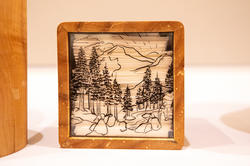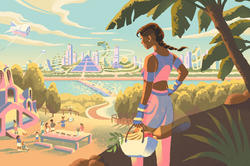Students in a new Illustration studio taught by Mary Jane Begin develop cohesive styles and expressive characters to bring their stories to life.
Visual Narratives that Inspire Change

“Be mindful about what you want viewers to take away from your image and how didactic you want to be. This piece has layers of information embedded in it and almost functions as an infographic. I think the message is very clear.”
“Be mindful about what you want viewers to take away from your image and how didactic you want to be.”
Visiting wildlife artist and RISD alum Walton Ford 82 FAV offered these words of encouragement to Will Roth 23 IL at a November crit led by faculty members Jean Blackburn 79 PT and Lucy Spelman. The two are teaming up this semester to teach Visual Stories of Natural Histories, a studio straddling the Illustration and History, Philosophy and the Social Sciences departments and focused on using visual storytelling to demonstrate how human societies impact natural systems.


“The class is about finding important narrative threads embedded in scientific data and weaving them into works of art that inspire ecological change,” Blackburn explains. “Students often find scientific research intimidating, and we’re helping them to put a human face on it.”
“We’re looking for inspiration in the work of various artists who address the impact of human activity on nature.”
“We’re looking for inspiration in the work of various artists who address the impact of human activity on nature,” Spelman adds, “including Walton, who explores the topic of human-animal interactions by constructing fabulous paintings that tell compelling stories.” Spelman recently returned from Africa, a continent she visits regularly as a board-certified zoological medicine specialist and wildlife conservationist.


Roth is researching camels and their 5,000-year relationship with humans. “I was inspired to create this mural by Rusty and Lucky, two camels I met on Block Island,” he says. “I’m planning to use a plotter to print the piece out on a long scroll and thinking about having one side fade into night, but I’m worried that it might get too cheesy.”
“I’m all about the cheese!” Ford exclaims in response. “Throw the kitchen sink at it! Young artists need to be encouraged to try things out. You were already discouraged enough before you got to RISD.”
“I want these creatures to be a little more beautiful and a little less horrific.”
Senior Ant Qiu 23 IL shares his project next, a series of sea monsters emerging from dying bodies of water. “I want these creatures to be a little more beautiful and a little less horrific,” he explains.


Ford is wowed by the series. “You could build the models for the next Korean horror movie,” he quips. “And it’s great to see you overturning the cliché monster trope. The original King Kong is so great because he’s vulnerable.”
Ford first met this group of students earlier in the semester when they visited his studio in New York City. Much of his work is intended to influence the way people interact with nature, and he is currently completing a commission for the new American Embassy in Namibia as part of the US Department of State’s Art in Embassies (AIE) program.

Washington, DC-based public art expert Welmoed Laanstra, who has curated numerous AIE exhibitions around the world, also visited the class and shared her take on the importance of AIE’s mission. “These commissions offer opportunities for cross-cultural exchange,” she says. “The objective is not to decorate the embassies, but to create compelling narratives that are accessible to embassy visitors.”
Laanstra says the Walton Ford commission was something of a no-brainer since the artist and the African country in question are both famous for their wildlife. “But he’s planning to put an interesting spin on the piece,” she adds, “rather than painting an existing animal.”
“The objective is not to decorate the embassies, but to create compelling narratives that are accessible to embassy visitors.”
Back in the Illustration Studies Building, Ford turns his attention to The Balloon Goes Up, a simple but effective accordion-style artist book in progress by senior Jocelyn Salim 23 IL. “I’m planning to produce it on a Risograph printer,” she says, “and make one side bright and cheery and the other—about the deadly effects of escaped balloons on turtles and other animals—dull and sad.”

“Your goal seems really manageable,” Ford notes. “A lot of environmental problems are so vast. But this little book with its accessible message and style could become popular with kids and have an impact on the world surprisingly quickly.”
—Simone Solondz
November 30, 2022


